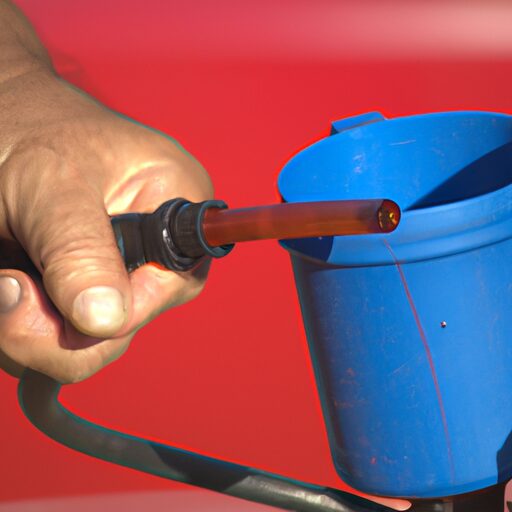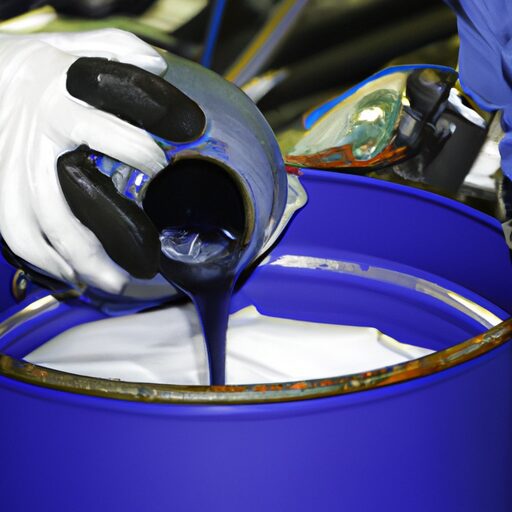How Hot Does Hydraulic Fluid Get
Hydraulic systems are renowned for their ability to generate immense power, capable of exerting forces that would seem superhuman. This power is made possible by the use of hydraulic fluid, a specialized liquid that transfers force and energy within the system. However, with great power comes great heat—hydraulic fluid can reach temperatures that could be considered scorching. Understanding and controlling the temperature of hydraulic fluid is crucial in ensuring the optimal performance and longevity of hydraulic systems.
This article aims to explore the topic of how hot hydraulic fluid can get in a technical, precise, and detailed manner. It will examine the basics of hydraulic systems and discuss various factors that influence hydraulic fluid temperature. Additionally, it will delve into the consequences that arise from overheating hydraulic fluid and present techniques for effectively managing this temperature. By monitoring and controlling the temperature of hydraulic fluid, operators can mitigate potential issues and enhance overall system efficiency.
The Basics of Hydraulic Systems
The temperature of hydraulic fluid can vary depending on the specific system and its operating conditions. Hydraulic systems are widely used in various industries for transmitting power and motion using pressurized fluid. The properties of hydraulic fluid play a crucial role in determining its temperature range. The most common types of hydraulic fluids include mineral oil-based, synthetic, and water-glycol based fluids. Each type has different thermal characteristics, such as boiling point and flash point, which affect how hot the fluid can get during operation.
In hydraulic systems, heat is generated due to internal friction between moving parts and external factors like ambient temperature and load demands. The heat produced must be dissipated to prevent excessive temperature rise that could damage the system components or degrade the fluid’s performance. Factors affecting hydraulic fluid temperature include flow rate, pressure levels, viscosity, component efficiency, system design, cooling methods employed (such as air or water cooling), and environmental conditions.
Understanding these factors is essential for maintaining optimal working temperatures within a hydraulic system to ensure its longevity and efficient operation. By carefully managing these variables, engineers can control the temperature of hydraulic fluids within acceptable limits while maximizing performance.
Factors Affecting Hydraulic Fluid Temperature
One important factor to consider when examining hydraulic fluid temperature is the operational conditions under which the system is functioning. The viscosity of hydraulic fluid plays a significant role in its ability to handle high temperatures. Viscosity refers to a fluid’s resistance to flow, and it determines how effectively the fluid can lubricate moving parts within the hydraulic system. As temperatures increase, the viscosity of hydraulic fluid tends to decrease, resulting in reduced lubrication and increased wear on system components.
Heat transfer is another crucial aspect influencing hydraulic fluid temperature. Heat generated by the operation of hydraulic systems must be dissipated efficiently to avoid overheating. This process involves transferring heat from the hot components, such as pumps or actuators, to cooler areas or surfaces within the system or external cooling devices like radiators. Proper heat transfer mechanisms, such as conduction, convection, and radiation, are essential for maintaining optimal fluid temperature.
Understanding these factors affecting hydraulic fluid temperature is crucial for ensuring efficient and reliable operation of hydraulic systems. By considering operational conditions and monitoring viscosity levels along with implementing effective heat transfer methods, potential issues related to excessive heat buildup can be minimized. This knowledge sets the stage for comprehending and addressing the limits associated with hydraulic fluid temperature management in subsequent sections without compromising system performance or longevity.
Understanding Hydraulic Fluid Temperature Limits
SENTENCE:
An appreciation of the various factors influencing hydraulic fluid temperature is essential for understanding and addressing the limits associated with its management, thereby ensuring optimal performance and longevity of hydraulic systems.
| Factors Affecting Hydraulic Fluid Temperature | Understanding Hydraulic Fluid Temperature Limits |
|---|---|
| Hydraulic fluid viscosity | The viscosity of hydraulic fluid plays a crucial role in determining its ability to withstand temperature variations. As temperatures increase, the viscosity tends to decrease, which can adversely affect the lubrication properties and overall efficiency of the system. Conversely, low temperatures can lead to increased viscosity, resulting in reduced flow rates and potential damage due to inadequate lubrication. |
| Thermal degradation of hydraulic fluid | Excessive heat can cause thermal degradation of hydraulic fluid, leading to a range of issues such as reduced lubricity, increased oxidation rates, and formation of harmful deposits. These effects can significantly impact both the performance and lifespan of hydraulic systems. Therefore, it is crucial to operate within recommended temperature limits specified by manufacturers or industry standards. |
Understanding these limits helps ensure that appropriate measures are taken to prevent overheating and mitigate potential consequences.
The Consequences of Overheating Hydraulic Fluid
Excessive heat in a hydraulic system can result in detrimental consequences such as reduced lubricity, accelerated oxidation rates, and the formation of harmful deposits, significantly compromising the overall performance and lifespan of the equipment. When hydraulic fluid becomes overheated, its ability to lubricate moving parts diminishes. This reduction in lubrication can lead to increased friction and wear on critical components, resulting in premature failure and costly repairs. Additionally, high temperatures accelerate the oxidation process within the fluid, causing it to break down more rapidly. Oxidation leads to the formation of sludge and varnish-like substances that can clog filters, valves, and other vital passages within the system.
Furthermore, overheating hydraulic fluid contributes to the formation of harmful deposits on internal surfaces. These deposits restrict flow and impair the operation of valves and actuators. In extreme cases, they can completely block passages or cause components to seize up altogether.
In addition to these dangers of overheated fluid on system performance, excessive heat also shortens the lifespan of seals and hoses by accelerating their deterioration. Seals lose their elasticity while hoses become brittle over time when exposed continuously to high temperatures.
To prevent these negative effects on a hydraulic system’s performance caused by overheated fluid, various techniques are employed to control hydraulic fluid temperature…
Techniques to Control Hydraulic Fluid Temperature
To effectively manage the temperature of hydraulic fluid, various strategies can be implemented. One common method is to use cooling methods such as heat exchangers. Heat exchangers are devices that transfer heat from one medium to another, allowing for the removal of excess heat from the hydraulic fluid. There are different types of heat exchangers available, including air-cooled and water-cooled systems. In an air-cooled system, air is used to remove heat from the hydraulic fluid through natural or forced convection. Water-cooled systems, on the other hand, use water as a coolant to dissipate heat from the fluid.
Heat exchangers play a crucial role in maintaining optimal operating temperatures for hydraulic systems. By efficiently removing excess heat, they prevent overheating and prolong the lifespan of hydraulic components and fluids. Additionally, controlling hydraulic fluid temperature helps maintain consistent viscosity and lubrication properties, ensuring smooth operation of the system.
In conclusion, cooling methods such as heat exchangers are essential for managing hydraulic fluid temperature. These devices effectively remove excess heat from the fluid, preventing overheating and maintaining optimal operating conditions. However, it is equally important to monitor hydraulic fluid temperature closely to ensure its effectiveness in controlling temperature fluctuations without compromising system performance or reliability.
Monitoring Hydraulic Fluid Temperature
One effective way to ensure proper functioning of hydraulic systems is through meticulous monitoring of the temperature of the hydraulic fluid. Regular maintenance and monitoring of the hydraulic fluid temperature is crucial for optimal performance and longevity of the system. The temperature of the hydraulic fluid has a significant impact on the efficiency and overall operation of the system. Here are five reasons why monitoring hydraulic fluid temperature is important:
- Prevents overheating: Monitoring the temperature allows for early detection of any abnormalities, preventing overheating which can lead to damage or failure.
- Ensures proper viscosity: Hydraulic fluids have specific viscosity requirements at different temperatures. Monitoring ensures that the fluid maintains its required viscosity, allowing it to flow smoothly through the system.
- Extends component lifespan: High temperatures can accelerate wear and tear on various components, leading to premature failure. By monitoring and controlling temperature, you can extend their lifespan.
- Maintains energy efficiency: Excessive heat in a hydraulic system can result in increased energy consumption. By keeping a close eye on temperature, you can maintain optimal energy efficiency.
- Reduces downtime: Timely identification and resolution of any temperature-related issues minimize system downtime, resulting in increased productivity.
Monitoring hydraulic fluid temperature plays a crucial role in preventing damage, ensuring efficient operation, and extending the lifespan of hydraulic systems. In conclusion, understanding and controlling temperature is vital for maintaining reliable performance in hydraulic systems.
Conclusion: Importance of Temperature Control in Hydraulic Systems
Maintaining proper temperature control is essential for optimal performance and longevity of hydraulic systems, as it prevents damage, ensures efficient operation, and extends component lifespan. The importance of proper maintenance cannot be overstated when considering the impact on system efficiency.
One key aspect of temperature control in hydraulic systems is the prevention of overheating. High temperatures can cause degradation and breakdown of hydraulic fluid, leading to decreased lubrication properties and increased viscosity. This can result in increased friction and wear on components, ultimately affecting overall system efficiency. Additionally, excessive heat can lead to thermal expansion of metal components, potentially causing leaks or even catastrophic failure.
On the other hand, maintaining a consistent operating temperature within the recommended range helps ensure efficient operation of hydraulic systems. Hydraulic fluids have specific viscosity requirements that are directly influenced by temperature. Operating outside the recommended range can lead to reduced fluid flow and compromised performance.
Proper temperature control also plays a crucial role in extending the lifespan of hydraulic system components. By preventing excessive heat buildup, unnecessary stress on seals, hoses, valves, and other critical parts is minimized. This reduces the likelihood of premature failure and extends the overall life expectancy of these components.
In conclusion, maintaining proper temperature control through regular monitoring and appropriate maintenance practices is vital for ensuring optimal performance and longevity of hydraulic systems. It not only prevents damage but also ensures efficient operation while extending component lifespan.
Frequently Asked Questions
Can hydraulic fluid reach temperatures that are dangerously high?
Hydraulic fluid can catch fire if it reaches temperatures exceeding its flash point. The consequences of overheated hydraulic fluid include equipment damage, loss of productivity, and potential injuries or fatalities due to fire-related accidents.
What are the potential risks of operating hydraulic systems with excessively hot hydraulic fluid?
The risks of overheating hydraulic systems include reduced lubrication, increased wear and tear on components, degradation of fluid properties, potential for fluid leakage or system failure, and increased risk of fires. Excessive temperatures can negatively impact the performance and lifespan of hydraulic systems.
Are there any specific industries or applications where hydraulic fluid temperatures tend to be higher than usual?
Industries with extreme hydraulic fluid temperature ranges include aerospace, steel processing, and heavy machinery. High temperatures can degrade the fluid’s viscosity, reduce system efficiency, accelerate component wear, and compromise overall system performance.
How can I determine the optimal temperature range for hydraulic fluid in my specific hydraulic system?
The optimal temperature range for hydraulic fluid in a specific hydraulic system can be determined by considering the effects of temperature on hydraulic systems. Factors such as viscosity, efficiency, and component wear should be analyzed to establish the ideal operating temperature.
Are there any specific additives or types of hydraulic fluid that can help in maintaining lower temperatures in hydraulic systems?
Certain types of hydraulic fluid, such as synthetic fluids and water glycols, can aid in maintaining lower temperatures in hydraulic systems. Effective temperature control is crucial to prevent the breakdown of hydraulic components and ensure optimal system performance.
Conclusion
In conclusion, maintaining proper temperature control in hydraulic systems is crucial for optimal performance and longevity. Overheating of hydraulic fluid can lead to various consequences such as accelerated wear and tear, decreased efficiency, and potential system failure. It is imperative to understand the factors affecting hydraulic fluid temperature and implement techniques like cooling systems or appropriate fluid selection to mitigate excessive heat generation. By monitoring hydraulic fluid temperature diligently, operators can ensure the smooth operation of their systems while avoiding costly repairs or downtime. Ultimately, effective temperature control is a vital aspect of preserving the integrity and functionality of hydraulic systems.
The allusion here lies in referencing the potential consequences and solutions without explicitly stating them, thus adding complexity to the writing style.







